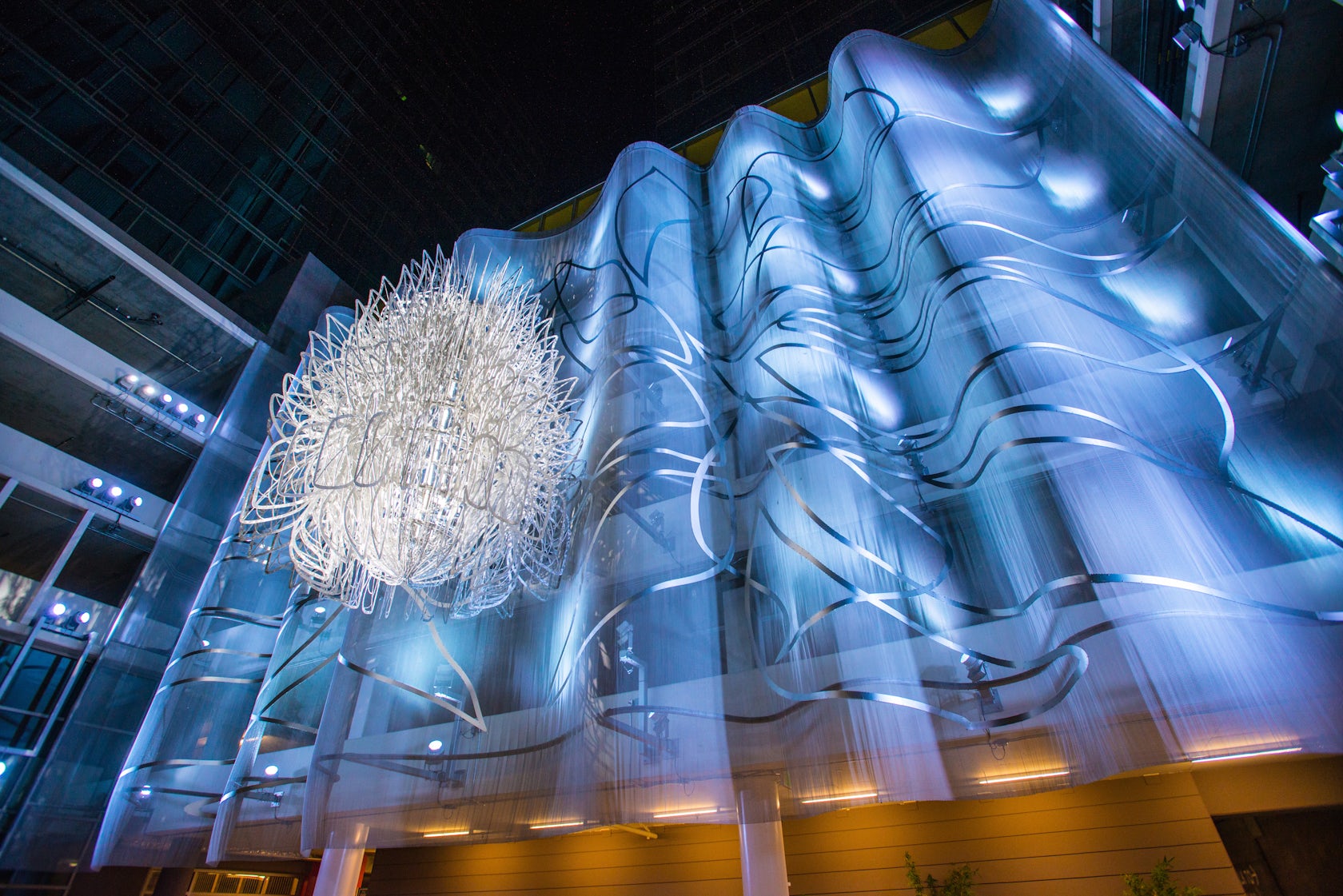Koreatown in Los Angeles offers a lot more than most traditional ethnic enclaves: it’s one of the biggest, densest, and most diverse areas in a city often criticized for sprawl and segregation. Challenging this popular conception of L.A., high rises and eclectic businesses line Koreatown’s walkable main corridors. Meanwhile, historic Art Deco apartments pack side streets, housing the wide array of residents, including Latino families, single young professionals, and of course, the largest Korean population in North America.

© Jeremy Green
“Los Angeles Opens Its Heart of Compassion” ©Cliff Garten Studio/Photography by Jeremy Green.
The Vermont, a luxury high rise of 464 apartments at the central intersection of Vermont and Wilshire Boulevard, has helped add to the district’s density and skyline. But in order to bring a complementary element to street level, developers turned to renowned L.A. sculptor Cliff Garten. For inspiration, Garten considered traditional Korean art, the diversity of the area, and, as he put it, “this overriding idea that Los Angeles is a city which is changing all the time. Like Baudelaire said, ‘This city changes faster than a beating heart,’ and that’s really true of L.A.”
The Vermont has a very clear view of L.A.’s changing landscape as its main pavilion lies directly across from an L.A. Metro subway station, which promises in coming years to connect several West Side neighborhoods to Koreatown and Downtown in a way never before possible. For an area looking past L.A.’s auto-centric stereotypes, Garten’s design fittingly transforms the Vermont’s parking structure into an engaging, multilayered work that celebrates diversity and the city’s forward momentum.

“Los Angeles Opens Its Heart of Compassion” ©Cliff Garten Studio/Photography by Jeremy Green.
Garten’s sculpture features a Fabricoil™coiled wire fabric system covering the parking garage and affixed with silver anodized line drawings of lotus petals. This façade creates a transparent background for the centerpiece sculpture, a three-dimensional aluminum lotus flower suspended 20 feet in the air. Because the Lotus is a fixture of Korean art and a symbol for the heart of compassion in certain meditations, Garten saw the combination of sculpture and façade as a representation for the area’s converging elements. “There are all of these overlapping cultures coming together all of the time that make Los Angeles,” he says — hence the title, “Los Angeles Opens Its Heart of Compassion.”
Out of the many finishes and materials available through Fabricoil, “Heart” utilizes a 5/16″ 14 gauge aluminum coiled wire fabric with a clear anodized finish and Clamp engineered attachment system. Garten was drawn to this particular system for its transparency, flexibility, and ability to capture light. The façade he designed curves both away from and toward the parking structure, letting the architecture behind it remain visible while also creating different shadows and depths depending on the time of day. After dark, LED lights turn the wire fabric into a pulsating canvas of alternating complementary colors, while the central Lotus is a constant, contrasting white.

© Jeremy Green
“Los Angeles Opens Its Heart of Compassion” ©Cliff Garten Studio/Photography by Jeremy Green.
“It’s that mishmash and overlapping of styles and concepts that makes the city,” Garten relates. “I think that’s the important thing about ‘Los Angeles Opens Its Heart of Compassion’ — it’s a complete understanding of this urban context and a sculptural projection into the architecture and the urban environment of this idea of overlapping and colliding cultures.”
Fabricoil’s available customizations also made it possible for Garten to deal with a more practical aspect of this corner in Koreatown: its scale. As he puts it, he had to address “one of the biggest scales in L.A., besides maybe Wilshire and Westwood or Downtown. So, it could take this big image, and the building needed that to actually compete with the rest of the urban context.” While some architects find traditional woven-metal systems cost-prohibitive for even small projects, like delineating interior spaces, Fabricoil offers an affordable solution for projects even of this size.

© Jeremy Green
“Los Angeles Opens Its Heart of Compassion” ©Cliff Garten Studio/Photography by Jeremy Green.
With a vast range of sizes and materials, Fabricoil can provide solutions to meet everything from practical ventilation to grand, artistic visions like Garten’s. Its versatility and malleability helped the artist bring his vision to life and played a part in what he likes about his fascinating addition to this evolving neighborhood: “I like the ability of the sculpture to kind of absorb everything. It absorbs the light, it absorbs the architecture, it absorbs the activity from the street consciously … It’s permeable, which again is a reference to the big permeable sponge that is L.A., where neighborhoods contract and expand according to economics and social change.”



